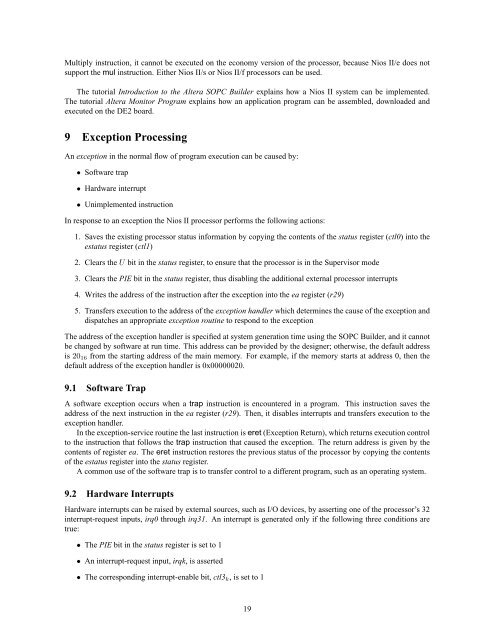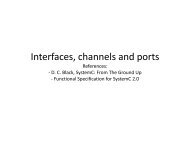Introduction to the Altera Nios II Soft Processor - FTP - Altera
Introduction to the Altera Nios II Soft Processor - FTP - Altera
Introduction to the Altera Nios II Soft Processor - FTP - Altera
Create successful ePaper yourself
Turn your PDF publications into a flip-book with our unique Google optimized e-Paper software.
Multiply instruction, it cannot be executed on <strong>the</strong> economy version of <strong>the</strong> processor, because <strong>Nios</strong> <strong>II</strong>/e does not<br />
support <strong>the</strong> mul instruction. Ei<strong>the</strong>r <strong>Nios</strong> <strong>II</strong>/s or <strong>Nios</strong> <strong>II</strong>/f processors can be used.<br />
The tu<strong>to</strong>rial <strong>Introduction</strong> <strong>to</strong> <strong>the</strong> <strong>Altera</strong> SOPC Builder explains how a <strong>Nios</strong> <strong>II</strong> system can be implemented.<br />
The tu<strong>to</strong>rial <strong>Altera</strong> Moni<strong>to</strong>r Program explains how an application program can be assembled, downloaded and<br />
executed on <strong>the</strong> DE2 board.<br />
9 Exception Processing<br />
An exception in <strong>the</strong> normal flow of program execution can be caused by:<br />
• <strong>Soft</strong>ware trap<br />
• Hardware interrupt<br />
• Unimplemented instruction<br />
In response <strong>to</strong> an exception <strong>the</strong> <strong>Nios</strong> <strong>II</strong> processor performs <strong>the</strong> following actions:<br />
1. Saves <strong>the</strong> existing processor status information by copying <strong>the</strong> contents of <strong>the</strong> status register (ctl0) in<strong>to</strong> <strong>the</strong><br />
estatus register (ctl1)<br />
2. Clears <strong>the</strong> U bit in <strong>the</strong> status register, <strong>to</strong> ensure that <strong>the</strong> processor is in <strong>the</strong> Supervisor mode<br />
3. Clears <strong>the</strong> PIE bit in <strong>the</strong> status register, thus disabling <strong>the</strong> additional external processor interrupts<br />
4. Writes <strong>the</strong> address of <strong>the</strong> instruction after <strong>the</strong> exception in<strong>to</strong> <strong>the</strong> ea register (r29)<br />
5. Transfers execution <strong>to</strong> <strong>the</strong> address of <strong>the</strong> exception handler which determines <strong>the</strong> cause of <strong>the</strong> exception and<br />
dispatches an appropriate exception routine <strong>to</strong> respond <strong>to</strong> <strong>the</strong> exception<br />
The address of <strong>the</strong> exception handler is specified at system generation time using <strong>the</strong> SOPC Builder, and it cannot<br />
be changed by software at run time. This address can be provided by <strong>the</strong> designer; o<strong>the</strong>rwise, <strong>the</strong> default address<br />
is 20 16 from <strong>the</strong> starting address of <strong>the</strong> main memory. For example, if <strong>the</strong> memory starts at address 0, <strong>the</strong>n <strong>the</strong><br />
default address of <strong>the</strong> exception handler is 0x00000020.<br />
9.1 <strong>Soft</strong>ware Trap<br />
A software exception occurs when a trap instruction is encountered in a program. This instruction saves <strong>the</strong><br />
address of <strong>the</strong> next instruction in <strong>the</strong> ea register (r29). Then, it disables interrupts and transfers execution <strong>to</strong> <strong>the</strong><br />
exception handler.<br />
In <strong>the</strong> exception-service routine <strong>the</strong> last instruction is eret (Exception Return), which returns execution control<br />
<strong>to</strong> <strong>the</strong> instruction that follows <strong>the</strong> trap instruction that caused <strong>the</strong> exception. The return address is given by <strong>the</strong><br />
contents of register ea. The eret instruction res<strong>to</strong>res <strong>the</strong> previous status of <strong>the</strong> processor by copying <strong>the</strong> contents<br />
of <strong>the</strong> estatus register in<strong>to</strong> <strong>the</strong> status register.<br />
A common use of <strong>the</strong> software trap is <strong>to</strong> transfer control <strong>to</strong> a different program, such as an operating system.<br />
9.2 Hardware Interrupts<br />
Hardware interrupts can be raised by external sources, such as I/O devices, by asserting one of <strong>the</strong> processor’s 32<br />
interrupt-request inputs, irq0 through irq31. An interrupt is generated only if <strong>the</strong> following three conditions are<br />
true:<br />
• The PIE bit in <strong>the</strong> status register is set <strong>to</strong> 1<br />
• An interrupt-request input, irqk, is asserted<br />
• The corresponding interrupt-enable bit, ctl3 k , is set <strong>to</strong> 1<br />
19

















